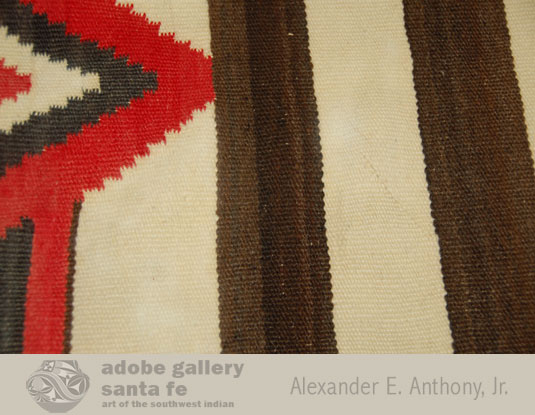Diné Transitional Third Phase Chief Blanket [SOLD]
+ Add to my watchlist Forward to Friend
- Category: Navajo Textiles
- Origin: Diné of the Navajo Nation
- Medium: wool
- Size: 54” x 67-1/2”
- Item # C3969H SOLD
The first “Chief Blanket” was a design of alternating brown and white horizontal stripes. They were, however, more finely woven than the 18th-century stripe textiles. Those First Phase Chief Blankets were woven between 1800-1850. By the end of that phase, weavers were more confident and experimental and began incorporating red into the pattern, resulting in what is now known as the Second Phase Chief Blanket (1850-1865). By the 1860s, the weavers were emboldened and exploded with confidence and added nine large diamond spots over the First and Second Phase design, resulting in the Third Phase Chief Blanket. The blanket phase of Navajo textiles came to an end in the 1880s when traders encouraged the weavers to make larger weavings useful as rugs. That was what they had a market for.
There was a period between the end of the classic phase of weaving and the complete introduction of rug size textiles that is known as the transitional period. This was the period when weavers were transitioning from what they were used to making, to making what the traders wanted. This period is described as occurring between 1880 and 1920.
During the transitional period, Third Phase Chief Blankets were woven in the traditional pattern but in larger sizes—a size suitable for use on the floor or displayed on the wall, but too large to be worn as a blanket. That is what this Third Phase textile represents. It is probably from the very early 1900s, is of blanket quality, but too large to serve as a wearing blanket. It was woven from churro wool with the only dye being an aniline red.
Condition: this Diné Transitional Third Phase Chief Blanket is in excellent condition
Provenance: from a private collection
Recommended Reading: Navajo Weaving Tradition: 1650 to the Present by Chris Selser and Alice Kaufman
Relative Links: Navajo textiles, Diné - Navajo Nation

- Category: Navajo Textiles
- Origin: Diné of the Navajo Nation
- Medium: wool
- Size: 54” x 67-1/2”
- Item # C3969H SOLD



